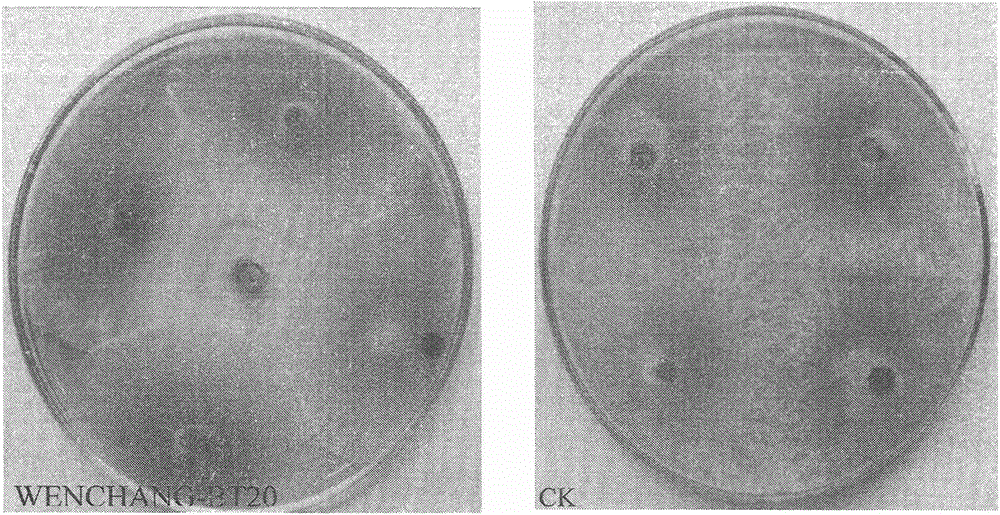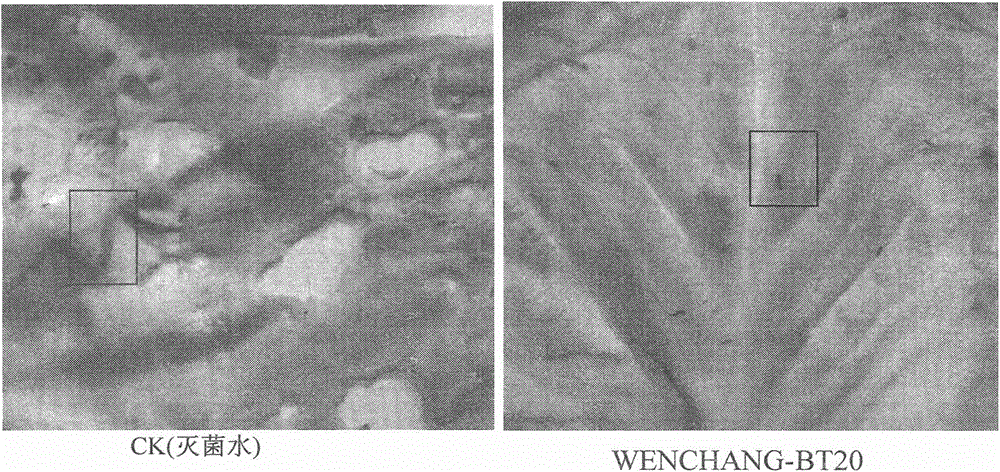Bacillus thuringiensis for inhibiting stem bleeding disease of coconut and killing lepidoptera pests and application thereof
A technology of Bacillus thuringiensis and Bacillus aureus, which is applied in the application, fungicides, insecticides and other directions, can solve the problems of insecticide resistance, harm, and difficulty in harm, and achieve strong insecticidal virulence and insecticidal effect. Good effect, the effect of inhibiting fungal diseases
- Summary
- Abstract
- Description
- Claims
- Application Information
AI Technical Summary
Problems solved by technology
Method used
Image
Examples
Embodiment 1
[0015] The isolation of embodiment 1 bacterial strain
[0016] Take an appropriate amount of soil sample and add it to the separation medium, cultivate it on a shaker at 30°C and 200rpm for 10 hours, then take a water bath at 80°C for 15 minutes, absorb 100 μL of the solid at each of the four concentrations (stock solution, stock solution diluted 10 times, 100 times, 1000 times) 1 / 2LB plate (coat two plates for each concentration), pour small glass beads and shake it left and right to spread the bacteria solution evenly. After standing at room temperature for 10 minutes, place the plate in a 30°C incubator. After 48 hours, observe the colony shape and select the bacteria similar to Bt. Colony smears were stained with fuchsin and examined under an oil microscope for the presence of spores and paraspore crystals. The Bacillus thuringiensis strains detected from the same isolate were selected according to their colony shape and color, vegetative body and spore crystal shape, etc...
Embodiment 2
[0018] The identification of embodiment 2 bacterial strains
[0019] Cultivate the Bt strain WENCHANG-BT20 on 1 / 2LB medium for 48 hours to form a single colony, the colony is milky white, round or nearly round, with neat edges, thicker in the middle of the colony, and gradually becomes thinner around the colony. Crystals were observed. Under the scanning electron microscope, it was observed that the bacterial body of the Bt strain was long rod-shaped, the spores were oblong rod-shaped, and the crystals were diamond-shaped ( figure 1 ).
[0020] 16S rDNA sequence amplification, sequence determination and molecular classification of WENCHANG-BT20 strain:
[0021] Extract the genomic DNA of the strain, and use the bacterial universal primers F (5'-AGAGTTTGATCCTGGCTCAG-3') and R (5'-AAGGAGGTGATCCAGCC-3') for polymerase chain reaction (PCR amplification), and the reaction condition is denaturation at 94°C for 1 minute , annealing at 52°C for 1 minute, extension at 72°C for 1 min...
Embodiment 3
[0026] Implementation example 3WENCHANG-BT20 measures the indoor insecticidal activity of diamondback moth
[0027]Using the leaf soaking method, set 8 experimental concentration gradients for the protein solution of WENCHANG-BT20, which are 1.6μg / mL, 0.8μg / mL, 0.4μg / mL, 0.2μg / mL, 0.1μg / mL, 0.05μg / mL , 0.025 μg / mL, 0.0125 μg / mL. Wash the cabbage leaves with clean water and dry them. Select fresh and consistent cabbage leaves and cut them into blocks of similar size. Soak them in protein solutions of various concentrations for 10 minutes, dry them, and put them into bioassay bottles. Each bottle receives 2-3 20 instar larvae, each treatment was repeated three times, kept warm in a biochemical incubator at 25°C, and after 72 hours of cultivation, the number of dead and alive larvae was investigated, and the feeding situation of the larvae was observed.
[0028] The bioassay results showed that the WENCHANG-BT20 protein had high insecticidal activity against diamondback moth. Th...
PUM
| Property | Measurement | Unit |
|---|---|---|
| Diameter | aaaaa | aaaaa |
Abstract
Description
Claims
Application Information
 Login to View More
Login to View More - R&D
- Intellectual Property
- Life Sciences
- Materials
- Tech Scout
- Unparalleled Data Quality
- Higher Quality Content
- 60% Fewer Hallucinations
Browse by: Latest US Patents, China's latest patents, Technical Efficacy Thesaurus, Application Domain, Technology Topic, Popular Technical Reports.
© 2025 PatSnap. All rights reserved.Legal|Privacy policy|Modern Slavery Act Transparency Statement|Sitemap|About US| Contact US: help@patsnap.com



